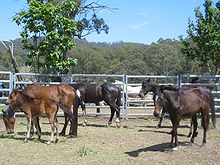|
Home Horse Breeds | First Posted: June 24, 2009 May 13, 2020 | |
Australian BrumbyModern Feral Horses 
Australia's first horses arrived here in 1788. Irregular shipments followed that initial cargo. Because of the conditions the horses lived under, only the fittest survived. Some horses died during the voyages. When horse racing was recognized as a sport in 1810, good quality thoroughbreds were imported from England to Australia. It is thought that the name Brumby for Australian feral horses is thought to have been derived from a James Brumby who arrived on the Britania in 1791. James Brumby, born in Scotton Lincolnshire, was a soldier with the New South Wales Corps, he was also a farrier and it is thought that he was responsible for some horses in the early Australian Colony. When James moved to Tasmania in 1804 it is thought that he left some horses in New South Wales. Locals asked who owned the horses, "they are Brumby's" was the reply. Whilst there is some uncertainty as to the origin of this name for horses the above appears the most certain route to their naming. The first horses were used for farm work, and contributed to the opening up of Australia's pastoral land. Explorers used horses and bullocks for transport. Horses were later bred for the remount trade. The low number and quality of fences, and infrequent musters, meant that many horses escaped. Some horses were also abandoned as machinery took over many of their tasks. Both groups of horses became feral. Type Brumbies are rarely of consistent size, conformation or color. This is because domestic mares may escape and join feral horse herds. Also, they were originally of mixed type, including draught and thoroughbred. Impact Brumbies are viewed as both a pest and a resource. They can cause damage to fences, overgraze cattle pastures, drink and foul water supplies, and make cattle mustering more difficult. They may also mate with domestic mares, and carry and pass on diseases. Their usefulness in Australia has been as meat, hair (for musical instruments, brushes, upholstery), and tourism/recreation. They can be captured and used as replacement stock horses, but demand is low. When the weather is dry, Brumbies may make water available by pawing at sandy creekbeds, providing water for wildlife and cattle as well as themselves. Because of the limited commercial need for these horses, regular culling is necessary, and studies have been carried out as to the most humane and efficient method. This culling is necessary not only to reduce the horses' impact on cattle farming, but for the protection of the horse herd. A large number of horses in drought conditions would suffer starvation, thirst, and may consume toxic plants. Summary Horses have played an important role in Australia's history. It is unfortunate that some became feral. It is up to us to control the size of the brumby herds, for their protection and our livelihood. Photographs: Mt Bundarrah Horse Adventures, Phillip and Louise Maguire, Mt Bundarrah Station, Via Omeo, Victoria, Australia 3898 Sources
Permission given by my dear friend, Cowboy Frank to use his breeds section. |